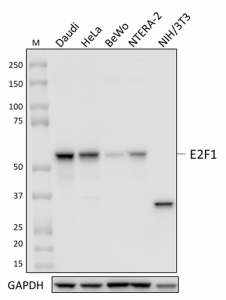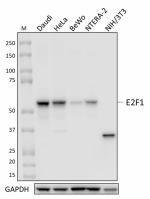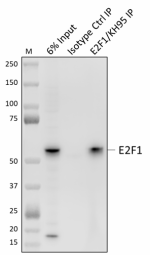- Clone
- E2F1/KH95 (See other available formats)
- Regulatory Status
- RUO
- Other Names
- PBR3, E2F Transcription Factor 1, Retinoblastoma-associated protein 1, Retinoblastoma-binding protein 3, RBAP-1, RBBP-3, PRB-Binding Protein E2F-1, Transcription Factor E2F1
- Isotype
- Mouse IgG2a, κ
- Ave. Rating
- Submit a Review
- Product Citations
- publications

-

Whole cell extracts (15 µg total protein) from the indicated cell lines were resolved by 4-12% Bis-Tris gel electrophoresis, transferred to a PVDF membrane, and probed with 0.25 µg/mL (1:2000 dilution) purified anti-E2F1 antibody (clone E2F1/KH95) overnight at 4°C. Proteins were visualized by chemiluminescence detection using HRP goat anti-mouse IgG antibody (Cat. No. 405306) at a 1:3000 dilution. Direct-Blot™ HRP anti-GAPDH antibody (Cat. No. 607904) was used as a loading control at a 1:25000 dilution (lower). Lane M: Molecular weight marker. -

Whole cell extracts (250 µg total protein) prepared from HeLa cells were immunoprecipitated overnight with 2.0 µg purified mouse IgG2a, κ isotype ctrl antibody (Cat. No. 400202) or purified anti-E2F1 antibody (clone E2F1/KH95). The resulting IP fractions and whole cell extract input (6%) were resolved by 4-12% Bis-Tris gel electrophoresis, transferred to a PVDF membrane and probed with a rabbit control antibody against a separate epitope of E2F1. Lane M: Molecular weight marker.
| Cat # | Size | Price | Quantity Check Availability | Save | ||
|---|---|---|---|---|---|---|
| 941101 | 25 µg | £81 | ||||
| 941102 | 100 µg | £201 | ||||
E2F1 is a member of the E2F family of transcription factors, which is comprised of 6 members that display both activator and repressor functions. The primary functions of E2F1 are transcription activation and cell cycle regulation, namely in replication, DNA-damage response and repair, and apoptosis. E2F1 activation during G1 phase of cell cycle is vital for the transition into S phase and the subsequent replication and synthesis of DNA. Beyond its role in cell cycle control, E2F1 is a regulator of metabolism, primarily through β cell proliferation, insulin secretion, endocrine function, and adipogenesis. E2F1 activity is regulated through its binding to phosphorylated retinoblastoma proteins (pRB) and through acetylation when in its pRB-free form.
E2F1 represents a critical target in cancer therapy. Through its stimulation of mTORC1 activity and tumor malignancy and growth, as well as its contribution to the Warburg effect by inducing glycolytic genes, E2F1 often behaves as an oncogene. Additionally, E2F1 can function as a tumor suppressor. Tumor-suppressive properties stem from its role in apoptosis through association with p53 and p73, as well as through inhibition of the NF-κB signaling pathway.
Product Details
- Verified Reactivity
- Human
- Antibody Type
- Monoclonal
- Host Species
- Mouse
- Immunogen
- Full-length recombinant human E2F1 protein
- Formulation
- Phosphate-buffered solution, pH 7.2, containing 0.09% sodium azide
- Preparation
- The antibody was purified by affinity chromatography.
- Concentration
- 0.5 mg/mL
- Storage & Handling
- The antibody solution should be stored undiluted between 2°C and 8°C.
- Application
-
WB - Quality tested
IP - Verified - Recommended Usage
-
Each lot of this antibody is quality control tested by western blotting. For western blotting, the suggested use of this reagent is 0.125 - 1.0 µg/mL. For immunoprecipitation, the suggested use of this reagent is 2.0 µg/test. It is recommended that the reagent be titrated for optimal performance for each application.
- Application Notes
-
This clone was tested for ICC using HeLa cells fixed with 4% paraformaldehyde and permeabilized with either methanol or Triton X-100. Neither method resulted in E2F1 staining.
This clone does not recognize mouse E2F1. However, when tested by western blot on mouse lysates, a ~35 kD protein of unknown origin was observed. - RRID
-
AB_2888772 (BioLegend Cat. No. 941101)
AB_2888772 (BioLegend Cat. No. 941102)
Antigen Details
- Structure
- E2F1 is a 437 amino acid protein with a predicted molecular weight of 47 kD.
- Distribution
-
Ubiquitously expressed/Nucleus
- Function
- Transcription factor/Cell cycle
- Biology Area
- Cell Biology, Cell Cycle/DNA Replication, Cell Death, DNA Repair/Replication, Transcription Factors
- Molecular Family
- Tumor Suppressors
- Antigen References
-
- Denechaud P, et al. 2017. Front. Endocrinol. 8:311.
- Liang Y, et al. 2015. Int. J. Oncol. 48:1650.
- Martinez-Balbas M, et al. 2000. Embo J. 19:662.
- Wu Z, et al. 2009. Int. J. Biochem. Cell Biol. 41:2389.
- Gene ID
- 1869 View all products for this Gene ID
- UniProt
- View information about E2F1 on UniProt.org
Other Formats
View All E2F1 Reagents Request Custom Conjugation| Description | Clone | Applications |
|---|---|---|
| Purified anti-E2F1 | E2F1/KH95 | WB,IP |
Compare Data Across All Formats
This data display is provided for general comparisons between formats.
Your actual data may vary due to variations in samples, target cells, instruments and their settings, staining conditions, and other factors.
If you need assistance with selecting the best format contact our expert technical support team.

 Login / Register
Login / Register 









Follow Us